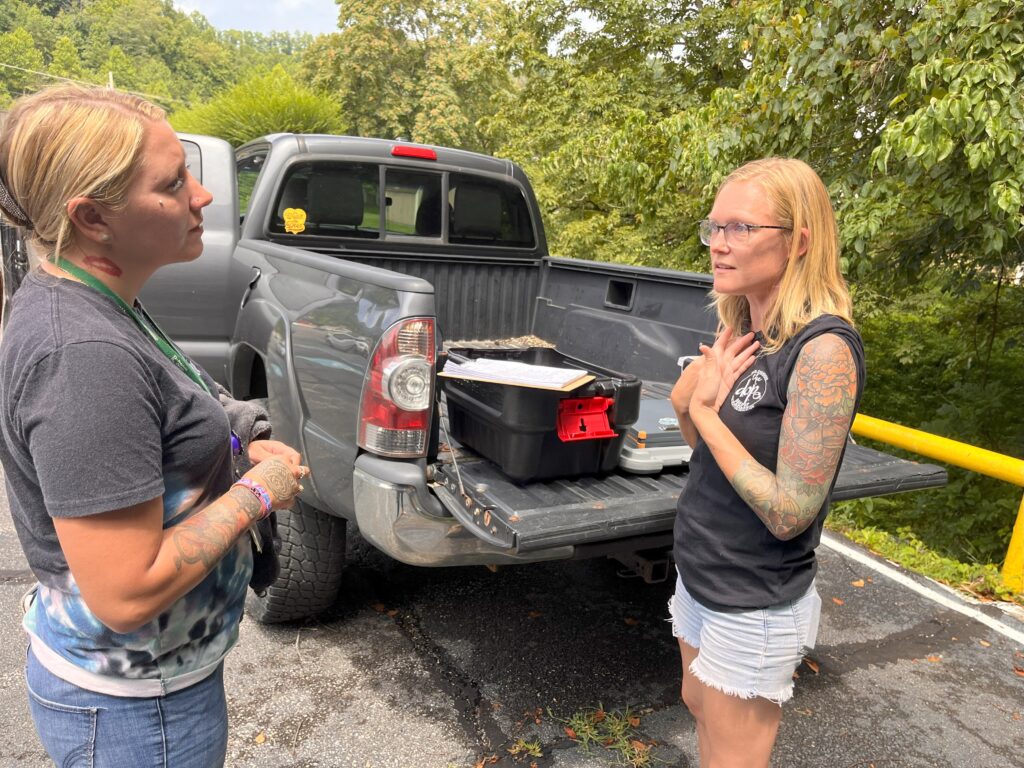Among U.S. states, West Virginia ranks 18th in the rate of new HIV infections. But that may not be the full picture, especially in rural communities, where some health officials are concerned that cases are going undetected.
Mingo County, in the far southwest of the state, is illustrative. On a late July morning, Keith Blankenship, the administrator of the Mingo County Health Department, is showing off his state of the art, mobile medical van: a 27-foot Mercedes, with just a few hundred miles on the odometer.
“It has a refrigerator. All it does lack is a sink; you have to use a portable hand washing station.” Blankenship said as he pointed to a small cart neatly packed with medical items, “We still have some of our supplies in there. We’ve done a lot of testing.”
Last year, Blankenship sent this van around the county, seeking out people to test for HIV. Over the course of a few months, he estimates they tested around 300 people. Even in that relatively small group, several people tested positive for HIV.
But you wouldn’t know it from the official state tally. West Virginia publishes a regular report showing HIV diagnoses by county. The data is preliminary, but gives health officials an indication of trends and potential trouble spots. For Mingo County, 2022 onwards shows nothing but zeroes, i.e. zero new cases.
Blankenship knows that’s not accurate, but he also knows that reporting a case requires a second, confirmatory test. Last year, when the county nurse tried to follow up and do a second test on those patients, they were nowhere to be found. Of the people who had tested positive, most were homeless or lacked a permanent address.
“Most times we only get one shot, or one chance to work with the person,” Blankenship said.
A spokeswoman for the state Department of Health (WVDH) told us in an email that the agency doesn’t have all the details in Mingo County, but that the agency has staff around the state, who help track people down to conduct confirmatory testing and to connect those patients with care.
“Even so, there are instances where individuals are not found. This is common among certain at-risk populations where unstable housing or drug misuse may be a factor,” the email read.
But Mingo County isn’t alone. In Nicholas County, according to Health Officer Anita Stewart, the state only confirmed four HIV cases in the past two years. But Stewart said the official count is just the tip of the iceberg.
“My concern is that if we have one case, we know that we have at least two to three more that are undiagnosed in our community already,” said Stewart. “And if it’s related to injection drug use, it’s probably higher than that.”
She said that data showing zero cases in intravenous drug users in Nicholas County does not reflect reality. Asked how big an issue HIV is in Nicholas and other small counties, Stewart replied, “It’s hard to know.”
One big reason is that in most counties, there is no regular outreach and testing program. As Blankenship explained, “You can’t get numbers if you don’t test for numbers.”
In Mingo County, the testing program he started is now on hold because the health department no longer has access to the mobile medical unit. Blankenship said the van was on loan from West Virginia’s Center for Threat Preparedness, but last October, he was told he could no longer operate it because there was no money allocated to pay for fuel, licensing, inspections and other maintenance.
Today, the van is parked in a lot within view of Blankenship’s third-floor office in downtown Williamson.
“I can look at it every day out my window,” he said.
The email statement from the WVDH called it “speculation” that there might be more HIV cases than are being reported. But it also said, “HIV testing is essential for improving the health of people living with HIV and reducing new HIV infections,” and that increased screening “is essential for identifying new cases especially amongst high-risk populations, such as individuals who inject drugs.”
In most rural counties, outreach to people at high risk for HIV involves a patchwork of small organizations. For a large swath of southern West Virginia, the job of knitting them together falls to Brooke Parker, a social worker with the Ryan White Program based at Charleston Area Medical Center. She coordinates efforts across 22 counties, in many cases enlisting local organizations that can conduct testing under what’s known as a CLIA waiver – essentially, an extension of the license to conduct medical testing, held by Charleston Area Medical Center.
“It means that we can empower smaller groups or volunteers, even though they’re not healthcare providers,” she explained.
Parker relies heavily on the knowledge of local peer counselors and volunteers. “Our peer recovery coaches in the community are powerhouses,” added Parker. “They know the people better than any of us ever will.”
One July afternoon, Parker headed to Lincoln County, about halfway between Charleston and Huntington. As far as she knows, there’s been no HIV testing in Lincoln County since late last summer. But she’s been connected with a woman who works at a local clinic and wants to help.
“Lindsy was telling me that she has people regularly asking her, ‘where can I get tested for HIV?’” Parker said.
Parker’s goal was to conduct a few tests, and to assess whether Lindsy Bias, a peer counselor, is ready to handle a testing program, going forward.
If she can, Parker said, “This is the targeted testing that I’ve been missing in Lincoln County for a long time.”
In nine of the past ten years, Lincoln County reported zero HIV cases in intravenous drug users. But between them, Parker and Bias personally know at least two residents who currently receive HIV treatment in either Charleston or Huntington.
“Our assumption is that there’s more cases than we know about,” said Parker.
The two women meet for the first time in a parking lot near West Hamlin. Asked if she believes the tally of zero reported cases, Bias scoffs. “It’s because nobody’s getting tested.”
Parker sets up her gear on the open bed of her pickup truck. It’s a simple, efficient assembly line. The initial finger prick takes blood for an Oraquick rapid HIV test, which produces results in about 20 minutes. She also runs tests for Hepatitis-C, syphilis, and finally a second HIV test, called the INSTI, which delivers results in just 60 seconds.
With two different tests, there’s no issue of having to find the patient to confirm results. Parker makes good use of the waiting period.
“It’s a point in time where you’ve got someone’s undivided attention,” she said. “I have people sitting with me and talking to me for 15 minutes at a time, which is amazing.”
She asks about barriers to health care, and about personal risk factors like drug use.
“Is there an opportunity for harm reduction education to come in? Fifteen minutes is enough time to teach someone how to bleach their syringes,” Parker said.
After running a few tests in the parking lot, it’s time for a house call. With Bias’ car leading the way, the group turned on a narrow dirt lane and drove another mile until reaching a spot with two small houses and a man in front, wrestling with the engine of a riding mower. Parker backed her truck into the driveway, as men, women and two friendly dogs trickle out to meet us.
Bias knows them all. They’ve been asking her about testing. A tall woman, around 50 years old, helps everyone read and sign the consent paperwork. One by one, they step forward to let Parker prick their fingers.
The tall woman said it’s been years since she was tested for HIV, which was the last time she went to rehab. She wants to go back, but said she needs to find someone who will take care of her dog while she’s gone. In the meantime she’s nervous about getting an infection, but said she probably wouldn’t have gotten herself tested if not for the home visit.
Parker has a routine. As each person’s test strip gives results, she asks them to come with her on a short walk, away from the group. She shares the news and answers questions in private. Today, most of the news is good, but a few people test positive for Hepatitis-C. She and Bias explain how treatment works. For those who don’t have insurance, Bias promised to come by the next day with paperwork, to help them sign up.
It’s a start, but every place presents a fresh challenge. In Nicholas County, “We’re trying to use data to help drive where we test,” Stewart said .
By closely monitoring the sites of overdoses as well as infections like syphilis and gonorrhea, she aims to focus testing on the people at highest risk, which stretches the budget of her small department.
“Our resources are very, very limited, whether that’s testing, supplies or staff capacity,” she said.
In Mingo County, Blankenship is still lobbying state officials to get his mobile unit back on the road. He said he’s just had an encouraging conversation with a senior official at the Center for Threat Preparedness.
“I’ve got high hopes,” Blankenship said. “I think that everybody involved wants to do the right thing, get it back on the road. As usual, there’s always legalities, but we’re trying to let our voice be heard, that the people of Mingo County deserve that van to be put in use.”
Editor’s Note: This story is part of a series we’re calling “Public Health, Public Trust,” running through August. It is a collaboration with the Global Health Reporting Center and is supported by the Pulitzer Center.























